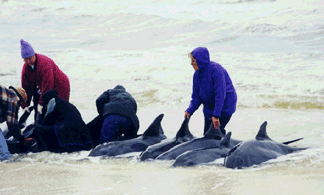Marine
Mammal Health and Stranding Response Program
  2004
Bottlenose Dolphin Unusual Mortality Event Along the Florida
Panhandle 2004
Bottlenose Dolphin Unusual Mortality Event Along the Florida
Panhandle
Entangled
Juvenile Right Whale, Kingfisher
NOAA
Team Postpones Attempt to Remove Ropes From
Endangered Right Whale
Marine
mammal stranding networks in the United States make up
one
facet of a broader, more comprehensive program called
the Marine
Mammal Health and Stranding Response Program (MMHSRP),
established in the late 1980s in response to growing
concern
about marine mammals washing ashore in U.S. waters.
The MMHSRP goals are: to facilitate collection and dissemination
of data,
to assess health trends in marine mammals, to correlate
health with available data on physical, chemical, environmental,
and biological parameters, and to coordinate effective
responses to unusual mortality events. For a copy of
the Marine
Mammal Health and Stranding Response Program: Program
Development
Plan (PDF), click here.
This
program was formalized by the 1992 Amendments to the Marine
Mammal Protection Act, and the National Marine Fisheries Service
(NMFS) was designated as the lead agency to coordinate related
activities. The program has the following components: stranding
networks, responses/investigations of mortality events, biomonitoring,
tissue/serum banking and analytical quality assurance.
Stranding Networks
To respond to marine mammal
strandings, volunteer stranding networks were established
in all coastal states and are authorized through Letters of
Authority from the NMFS regional offices. Through a National
Coordinator and five regional coordinators, NMFS oversees,
coordinates, and authorizes these activities and provides
training to personnel. For a copy of the Level
A data form (OMB used by stranding networks in the collection
of marine mammal stranding data, click
here ).
Biomonitoring
In recent years, high
concentrations of potentially toxic substances in marine mammals
and an increase in new diseases have been documented, and
scientists have begun to consider the possibility of a link
between these toxic substances and marine mammal mortality
events. These studies contribute to a growing, worldwide effort
of marine mammal biomonitoring not only to help assess the
health and contaminant loads of marine mammals, but also to
assist in determining anthropogenic impacts on marine mammals,
marine food chains and marine ecosystem health. NMFS provides
participants in the program with training and some financial
support. Using strandings, and bycatch animals, the participants
provide tissue/serum archiving, samples for analyses, disease
monitoring and reporting and additional response during disease
investigations.
The Analytical Quality
Assurance (AQA)
This aspect of the MMHSRP
was designed to ensure accuracy, precision, level of detection,
and intercomparability of data in the chemical analyses of
marine mammal tissue samples. The AQA consists of annual interlaboratory
comparisons and the development of control materials and standard
reference materials for marine mammal tissues. The new NIST
Charleston facility is taking the lead for this activity.
Response to Unusual
Mortality Events
In response to the 1987-88
dolphin die-off, NMFS established a Working Group on Unusual
Marine Mammal Mortality Events to create criteria for determining
when an unusual mortality event is occurring and then to direct
responses to such events. The Working Group is periodically
called upon to lend its expertise in situations where circumstances
indicate an unusual mortality event may be occurring and may
provide guidance throughout the event. This Group meets annually,
and at the last meeting discussed many issues including recent
mortality events involving endangered species both in the
United States and abroad. Through consultation with other
government agencies, the Working Group has been able to build
on its existing knowledge of mortality events to better respond
to unusual marine mammal mortality event.
National Marine Mammal
Tissue Bank
The National Marine Mammal
Tissue Bank was formally established in 1992 and provides
protocols and techniques for the long-term storage of tissues
from marine mammals for retrospective contaminant analyses.
The Tissue Bank is currently expanding at the Ft Johnson NOAA
facility in Charleston, South Carolina. The Tissue Bank uses
the biomonitoring sites noted above and other trained personnel
to collect tissues on specific indicator species (Atlantic
bottlenose dolphins, Atlantic white sided dolphins, pilot
whales, harbor porpoise), mass stranding animals, and mortality
events. In addition, a serum bank and long-term storage of
histopathology tissues are being developed.
Marine
Mammals Ashore CD-ROM
Through
a cooperative effort between the NMFS Office of Protected
Resources, National Ocean Service’s Office of Ocean Resources
Conservation and Assessment, and the National Aquarium in
Baltimore, Marine Mammals Ashore: A Field Guide for Strandings
by Geraci and Lounsbury has been adapted into a CD-ROM format.
The CD-ROM includes the entire original publication in PDF,
as well as updated information, stranding forms, and a multimedia
overview including interactive discussions by marine mammal
experts from around the world. The CD-ROM is compatible with
most PC and Macintosh computers.
Marine
Mammals Ashore: A Field Guide for Strandings was originally
published in 1993 as one of the most comprehensive guides
for marine mammal stranding response and rehabilitation ever
compiled. Since its initial publication, this field guide
has provided countless numbers of marine mammal rehabilitators
and scientists around the world with information vital to
successful response, rehabilitation, and release of marine
mammals.
To
purchase this CD-ROM, please contact Valerie Lounsbury at
the National Aquarium in Baltimore by e-mail at: vlounsbury@aqua.org
or by mail at: Pier 3, 501 East Pratt Street, Baltimore, MD
21202-3194. You can also purchase the CD-ROM online from the
National Aquarium in Baltimore.
Photo
Credit: Ron Hardy, GulfWorld
|

